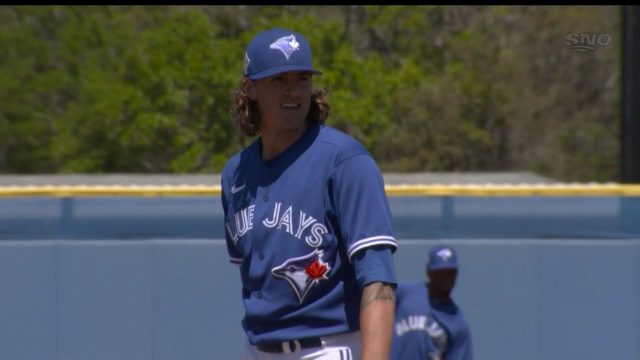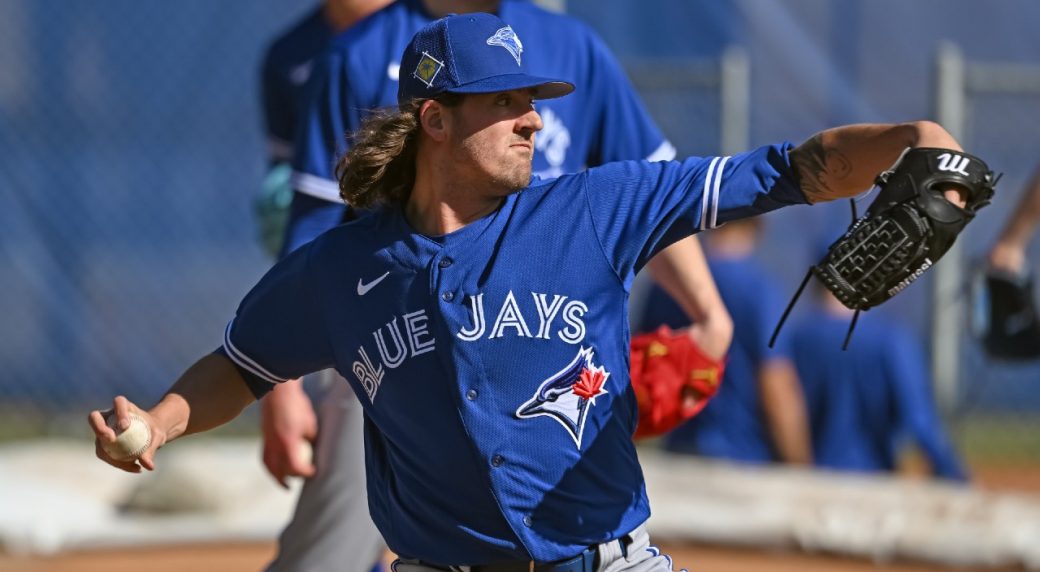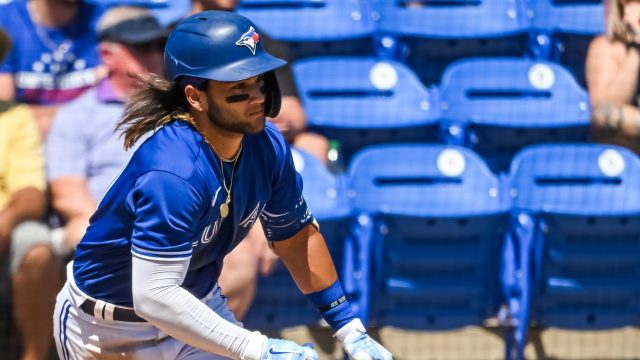DUNEDIN, Fla. — Kevin Gausman’s going to have an awful, bloody, half-dime-sized blister on the inner tip of his right finger Friday night. At least he’s hoping that he does.
That will mean that Gausman’s splitter — the nasty, diving, oft-unhittable pitch he’s made his career on — was really working as he pitched in an intrasquad game at the Blue Jays player development complex Friday afternoon. Gausman’s grip of the pitch is so funky, and the amount of force he puts behind it so great, that a painful blister is inevitable. It’s welcome. A truly encouraging sight to see.
“If I'm warming up and I see a little blister starting, I know, 'All right, the split is going to be good today,'” Gausman says. “And the bigger my blister is, the better my split will be that day.”
The splitter is an uncommon pitch across MLB. Last season, only 40 pitchers threw one a minimum of 50 times. And of that group, only five used it for a greater proportion of their total pitches than Gausman. That’s because it’s a hard pitch to learn and an even harder one to locate consistently. And if you haven’t conditioned yourself to the funky grip necessary to create its sharp, downward action, it's uncomfortable as hell.
Throwing it is uncomfortable for Gausman, too. He’s just conditioned himself to it. His final point of contact with the ball when the splitter leaves his hand is the inside edge of his middle finger right along the nail, which he uses to put an enormous amount of pressure on the seam of the baseball and create the over 1,500 revolutions per minute of spin that help make the pitch so effective.
But a side effect of all that force is a blister caused by the intense friction between the baseball’s seam and Gausman’s finger. It’s inevitable. If Gausman doesn’t get one, he knows he’s not staying behind the ball and rolling it off his finger correctly. And if he’s not throwing the pitch correctly, he’s probably getting lit up.
As you might imagine, this unfortunate consequence requires careful management throughout the season in order for Gausman’s finger to remain manicured enough to make all of his starts. Which is why he has a nail care kit that goes everywhere with him. He spends a good 15 minutes in the training room each day having his finger tended to. His teammates in San Francisco gave him endless grief about it. Hey, make room, Gaus needs a trainer’s table for his fingernail.
It’s almost worth putting a trigger warning on this piece, not only for the squeamish, but for Blue Jays fans still scarred by the thought of pitchers experiencing blisters after a similar issue derailed the young career of Aaron Sanchez in 2017.
After dominating as a reliever during Toronto’s hell-raising 2015 postseason run, and leading the AL in ERA over 30 starts the following year, Sanchez was ultimately undone by the blisters he’d pitched through during his breakout, hitting the injured list four times over the course of a maddening 2017 in which he made only eight starts. Ultimately, Sanchez never looked like himself on the mound again.
Sanchez tried everything, including a surgical procedure that removed a vertical slice of his nail on the side of his right middle finger where the blisters were occurring. He even considered a chemical treatment that would have prevented that removed portion of his nail from ever growing back. Gausman remembers Sanchez reaching out to him for advice about it at the time.
“His was pretty extreme,” Gausman says. “When I saw a picture of his, I was like, ‘Oh no.’ Because I knew what he was in for.”
Gausman and Sanchez first met at a high school showcase when they were only 16. They ended up signing with the same agent, and kept in touch throughout their early MLB careers, which both began in the American League East. Last year they were reunited again with the Giants, Gausman contending for a Cy Young award, Sanchez trying to salvage his once-promising career. It was nice to have someone else around with a finger care routine.
“We would talk a lot about our fingernails,” Gausman says. “Everybody has their own process, you know? Moises Alou used to pee on his hands because he got blisters on his fingers. I actually know a lot of guys who pee on their fingers.”
He also knows guys who soak their fingers in orange juice, believing the acidity toughens up the skin. He knows others who prefer lime juice. He knows guys who sweat a lot and pitch in hot climates who have undergone experimental procedures claiming to reduce perspiration from their hands.
He knows pitchers who periodically rub their hands against abrasive surfaces throughout the day, aiming to desensitize the nerve endings in their fingers. Gausman often does that one himself, rubbing his fingers against the pinstripe on the pant leg of his uniform. Orioles clubbies hated doing his laundry, because Gausman's pants were perpetually covered with dried dots of blood.
It's merely part of Gausman’s between-starts finger care routine, which he’s honed through constant experimentation over his nine-year MLB career. It starts immediately following an outing, when Gausman returns to the clubhouse to have his fresh blister popped, drained, and filled from a syringe with zinc oxide, which helps break down collagen and promotes healing.
Over the next several days, Gausman will use a small laser pen emitting light at high wavelengths to deliver energy into the tissue in and around the blister, helping it heal. That’s taken some trial-and-error, as it’s a relatively recent advancement in blister-healing technology. Five two-minute lasering sessions per day seems to be the sweet spot.
“If you do it for too long, man, it gets hot,” Gausman says. “You can burn yourself pretty easily doing it.”

The day after his start is uncomfortable. The day after that, a little less so. And by day three after an outing, the blister has typically healed enough for Gausman to be able to throw his bullpen.
Of course, he can’t throw his splitter in that side session — that would just create another blister. This has not gone over well with several pitching coaches Gausman has worked with in his career. Let me get this straight, they’ll say. You can’t work on your most important pitch between outings?
“They’re like, ‘No, we need to throw it. We need to work on it.’ And I’m like, ‘I can’t do it. Do you want me to miss my start?’” Gausman says. “I've had so many people that are like, 'Oh, why don't you try to change your grip?’ Or, ‘Why don't you stop throwing your split?’ And I'm like, 'That's not an option.'”
It’s really not. Gausman, the owner of MLB’s seventh-lowest ERA among starters since 2020, is not here without that pitch. He doesn’t sign a life-changing, five-year, $110-million free agent contract with the Blue Jays if he doesn’t have it in his arsenal. He might not be a big-leaguer at all.
Gausman was on waivers three years ago; he was non-tendered and released months later. It wasn’t until he learned how to effectively tunnel his splitter off his fastball that Gausman turned his career around. It’s not only the game’s best splitter — it might be the game's best pitch.
So, just as the extraordinary results it produces — hitters mustered an absurdly low .192 xwOBA against Gausman’s splitter in 2021, the lowest of any MLB offering — are part and parcel to his success, so, too, are the blisters.
And the pitch doesn’t only create blisters on his skin — it cracks Gausman’s fingernail, as well. He’s already sporting bruising underneath his nail early in spring training from live batting practice sessions — and he knows it’ll get progressively worse and worse throughout the season as his nail cracks from the pressure.
Before MLB began policing its foreign substance ban, Gausman would reinforce the nail with an adhesive before taking the mound. He’s tried everything. Superglue. Fake nail products. A MacGyvered band-aid and glue combination.
“The superglue can be tricky, though. It gets too hard. And when you have something hard trying to be pliable on a dry surface, it has a tendency to rip,” he says. “That’s where a lot of guys get in trouble. They try to put superglue on a cut or a blister and it just creates more tension. That’s when they’ll rip their blister wide open. That’s when you see some pictures of it, and it’s like, ‘Oh my god — he’s going to miss a start or two.’”
Nowadays, Gausman uses a product called Dermabond — or 2-Octyl cyanoacrylate, if you want to be fancy — to glue his nail together between starts and give it a chance to heal. It takes him 5-10 minutes with tape remover and a file to get it off before his outings. In his nail kit, Gausman has a selection of tiny tools from a company called Tweezerman that he uses to meticulously dig under his nail and pick out bits of adhesive.
“It’s like liquid plastic,” he says. “Sometimes it gets under your nail and sticks to your skin, and that’s when you can rip open an already open wound and make it a lot worse. And if you don’t get it all off, it can just make the callus even bigger. It adds more pressure and weight on my finger.”
Ultimately, this is Gausman’s lot in life. He chose to throw baseballs for a living, chose to throw this particularly uncommon pitch. Constant blisters are just what comes with it. And it’s with him forever. He already has permanent scar tissue from all the blisters. He exposes it every off-season when he files his skin all the way down to let it regrow. It’ll probably get worse over his next five years in Toronto.
And that’d be a great thing. It would mean the pitch is working the way he needs it to, which last year produced a frontline starter’s results. Gausman says Blue Jays fans should expect to see him messing with his blister plenty during outings — scratching it on his pants, rubbing it between his fingers, inspecting it between innings. But it’s not cause for alarm. It’ll mean everything’s going according to plan.
“As the season goes, it’ll get pretty bad and my nail will start to look more and more funky. Sometimes I’ll throw a pitch and it’ll open up. There’ll be blood. And you’ll see me react — it’s painful. I definitely feel it,” he says. “It’s definitely a process between starts. But I know it well enough now where I can maintain it. You find what works. And I’ve been lucky enough where I haven’t missed a start because of it.”



